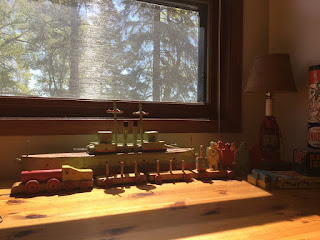Reflection on Wriston's Show "Pulped Under Pressure"
The Wriston show "Pulped Under Pressure" was really cool because the connective theme of handmade paper visually tied together every work by all the different women. Even though each artist had different specific motivations, the soft, subtle and airy quality of handmade paper was apparent throughout, which I really enjoyed. Indeed, this soft quality and the appearance of grains and the paper-making process of the artists' own hands lent itself to an idea of history (each work had a past life as paper in a different form) which was also apparent in most of the works. I found this aspect especially beautiful. It reminded me of when, in 6th grade science class, we collected natural and non-natural objects from the ground outside and blended them with construction paper to make "homemade paper" which turned out as these interesting paper disks which had a similar quality to the paper in this work.
In the gallery book "Pulped Under Pressure," I really enjoyed the discussion of multiple perspectives seen through paper, which was definitely apparent throughout the show. One of my favorite works, seen below, is titled "Wastemade" by Jillian Bruschera and is especially compelling because of its three dimensional nature. The fact that the paper turned to bricks, to me, seems really hopeful (in accordance with the title "Wastemade") because the artwork promotes an idea of building-up. Even though it seems unfinished, it implies a process of rebuilding is occurring. Indeed, a lot of the artists had a social commentary of activism, which this work definitely points to. As a whole, I think the show was really beautiful because of its collective cohesion, both visually and conceptually.

In the gallery book "Pulped Under Pressure," I really enjoyed the discussion of multiple perspectives seen through paper, which was definitely apparent throughout the show. One of my favorite works, seen below, is titled "Wastemade" by Jillian Bruschera and is especially compelling because of its three dimensional nature. The fact that the paper turned to bricks, to me, seems really hopeful (in accordance with the title "Wastemade") because the artwork promotes an idea of building-up. Even though it seems unfinished, it implies a process of rebuilding is occurring. Indeed, a lot of the artists had a social commentary of activism, which this work definitely points to. As a whole, I think the show was really beautiful because of its collective cohesion, both visually and conceptually.


Comments
Post a Comment